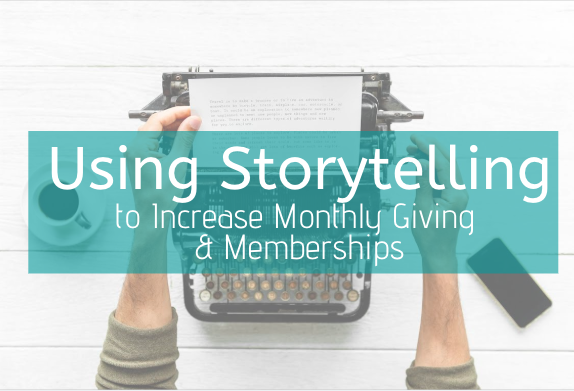Using Storytelling to Increase Monthly Giving & Memberships

The Story
When reaching out to people to raise awareness and attract new members or sponsors, one could argue that social media platforms represent a powerful medium between you and your audience. Nevertheless, billions of Facebook and Instagram users are just a crowd of people who like fast information—giving you a chance to make your story heard.
For most, storytelling played a significant role in our childhood. In school, most kids remember information better if they receive it through a story than as a simple fact, according to scientists. The same research shows that our brain activity increases when we listen to a story, and it’s also easier to connect to other people and feel empathy through storytelling. So how can you transfer such an effective technique to increase monthly giving at your nonprofit?
Provide a solution
As people read your story and connect with your organization’s mission, it’s essential to provide a straightforward solution to the problem that your mission aims to fix. Make sure to adjust your narrative so the audience would like to see themselves as a part of the driving force behind the solution to the issue. Furthermore, it is of utmost importance that you make it clear, even if you must create a step-by-step explanation of how the readers can become part of the resolution.
Cliffhangers
The oldest trick in the book, one would say. But it is rooted in accurate data. Scientific research shows that people are naturally inclined to complete nearly finished activities even if they don’t have to. If your story ends with a closure that puts the audience in a dilemma, you have a much higher chance of having them back for the sequel and sharing your content with their networks. Organic shares are also a valuable asset that can increase your traffic and conversion ratio.
Keeping the story balanced
It’s important to stress the urgency of your cause and the necessity to act fast. No matter how empathetic a person might be, too much of the heavy stuff can cause discomfort and unease and even stop the viewer from reaching the end of your storyline, which could lead to losing a potential donor. However, stories can convey a powerful message without being too dark and gloomy.
On the opposite side, if your story is too joyful, full of happy endings, and problems that resolve by thinking positive thoughts, your audience could feel that your cause is not that alarming and you don’t need immediate support. Find the balance between the light and dark, show the urgency, and show disturbing data, but make sure to leave room for some joy as a result of good people reaching out to help.
Providing context
Laying down the facts that concern your nonprofit organization doesn’t mean those facts will mean anything to a potential donor who is not yet aware of what those facts and numbers mean. Crafting a story depicting the real-life influence of the information you wish to share will attract more people and make it easier for them to connect with your concerns and take action.
Be mindful of the quality of the content.
The quality of your story includes the storyline’s complexity, the characters’ depth, and finally, its moral. However, spelling and grammar are also important factors that determine the quality of your work. According to some sources, poor grammar and spelling blunders distract the reader, disabling them from focusing on what matters. Online services like Uk.bestessays.com, AustralianWritings, Paperwritingpro.com, Pro Essay Writing, and many others could proofread the content for you until it’s spotless.
Find inspiration in real people and events.
We are social beings, and deep down inside, we care about each other, feel empathy, and understand personal tragedies and happiness. Instead of creating a fictional story, seek out a person that you know has a story that people would connect with. More importantly, find someone who can tell you a story that will inspire people to reach out to you, learn more about that person, and potentially help with your activities.
Don’t try to sell.
Remember that your story is about real people and real-life events with actual human value. Suppose you use too much technical terminology and keep pushing the audience into facts and figures, constantly trying to sell. In that case, the audience will have difficulty connecting to what they find challenging to understand. It’s not that hard to recognize that most of us better relate to a story about a person in a desperate situation than feeling sorry about the percentage of “low-income individuals,” “underdeveloped regions,” or “average number of children without proper education.” Create an honest, human story – don’t be a salesperson.
Conclusion
Stories have kept people close since the beginning of time. They make us feel that there is hope and good in people. They also teach us that there is a lot of darkness in the world, and we must fight together to stop it from spreading. Storytelling allows you to trigger human imagination and make them see and feel what you are trying to express. Make every word count!